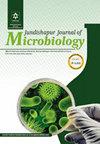The Molecular Characterization and Risk Factors of ST131 and Non-ST131 Escherichia coli in Healthy Fecal Carriers in Tehran, Iran
IF 0.5
4区 医学
Q4 MICROBIOLOGY
引用次数: 1
Abstract
Background: Commensal extended-spectrum β-lactamase (ESBL) producing Escherichia coli isolates in the gut can be the reservoir of virulence factors and resistance genes. Objectives: We investigated the molecular feature, risk factors, and quinolone/fluoroquinolone (Q/FQ) resistance in sequence type 131 (ST131) and non-ST131: ESBL-producing E. coli (EPE) isolates in healthy fecal carriers. Methods: A total of 540 fecal samples and its demographic data were collected from healthy adults in Tehran in 2018. ST131 isolates were identified by MLST analysis, and the characteristics of the virulence factor, phylogenic assay, and Q/FQ resistance genes in ST131 and non-ST131 were determined by polymerase chain reaction (PCR). Results: The EPE isolates mainly belonged to the commensal phylogenetic groups A (54.9%) and D (18.1%). The type 1 fimbriae (fimH; 89.6%) gene was the predominant virulence factor, and there was a significant correlation between ferric yersiniabactin uptake (fyuA; 52.9%), aerobactin receptor (iutA; 17.6%), and group II capsule synthesis (kpsMII; 35.3%) with ST131. In Q/FQ-resistant isolates, qnrS (19%) was the predominant gene, and mutations mostly occurred at codon S83 in GyrA The number of mutations in gyrA and parC genes was significantly higher in ST131 isolates than in non-ST131 isolates. There was a significant positive correlation between diabetes, male gender, and living in the south of the city with EPE carriage (P < 0.05). Conclusions: Accumulation of multiple virulence factors and high- level resistance to Q/FQ in some phylogroups (B2 and D), particularly ST131 isolates, require to be considered in detecting resistant isolates in healthy carriers. According to the risk factor for spreading of EPE isolates (diabetes, living in low-income parts of the city, and male gender), the necessary strategies are required to be developed to control the dissemination of antimicrobial-resistant isolates in the community.伊朗德黑兰健康粪便载体中ST131和非ST131大肠杆菌的分子特征及危险因素
背景:肠道中产生共生超广谱β-内酰胺酶(ESBL)的大肠杆菌分离株可能是毒力因子和抗性基因的宿主。目的:我们研究了健康粪便携带者中序列型131(ST131)和非ST131:ESBL产生大肠杆菌(EPE)分离株的分子特征、危险因素和喹诺酮/氟喹诺酮(Q/FQ)耐药性。方法:2018年,共从德黑兰的健康成年人身上收集了540份粪便样本及其人口统计数据。通过MLST分析鉴定了ST131分离株,并通过聚合酶链式反应(PCR)测定了ST131和非ST131的毒力因子、系统发育分析和Q/FQ抗性基因的特征。结果:EPE分离株主要属于共生系统发育群A(54.9%)和D(18.1%),1型菌毛(fimH;89.6%)基因是主要毒力因子,耶尔森氏菌素摄取量(fyuA;52.9%)、好氧菌素受体(iutA;17.6%)和ST131Ⅱ组荚膜合成量(kpsMII;35.3%)之间存在显著相关性。在Q/FQ抗性分离株中,qnrS(19%)是主要基因,突变主要发生在GyrA的密码子S83处。ST131分离株中GyrA和parC基因的突变数量显著高于非ST131分离物。结论:在健康携带者中检测耐药菌株时,需要考虑多种毒力因子的积累和某些门群(B2和D)对Q/FQ的高水平耐药性,特别是ST131分离株。根据EPE分离株传播的风险因素(糖尿病、生活在城市低收入地区和男性),需要制定必要的策略来控制抗微生物分离株在社区中的传播。
本文章由计算机程序翻译,如有差异,请以英文原文为准。
求助全文
约1分钟内获得全文
求助全文
来源期刊

Jundishapur Journal of Microbiology
MICROBIOLOGY-
CiteScore
1.30
自引率
0.00%
发文量
56
审稿时长
6-12 weeks
期刊介绍:
Jundishapur Journal of Microbiology, (JJM) is the official scientific Monthly publication of Ahvaz Jundishapur University of Medical Sciences. JJM is dedicated to the publication of manuscripts on topics concerning all aspects of microbiology. The topics include medical, veterinary and environmental microbiology, molecular investigations and infectious diseases. Aspects of immunology and epidemiology of infectious diseases are also considered.
 求助内容:
求助内容: 应助结果提醒方式:
应助结果提醒方式:


